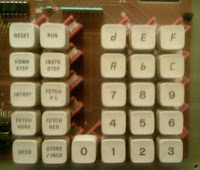 I just got this machine possessed. It is a microprocessor demonstration board based on the Intel 8085 CPU meaning that it was built for educational use and to demonstrate the capabilities of Intel's early 8 bit CPUs. According to a very few information on the web it was produced from 1978 through the early 80's by Hewlett-Packard.
I just got this machine possessed. It is a microprocessor demonstration board based on the Intel 8085 CPU meaning that it was built for educational use and to demonstrate the capabilities of Intel's early 8 bit CPUs. According to a very few information on the web it was produced from 1978 through the early 80's by Hewlett-Packard.
First impressions:
The nice leather briefcase makes the appearance really elegant, something that is missed from new and modern equipment. Also, push buttons are built for eternity, no lifetime by design.
Technical data:
Manufacturer: Hewlett-Packard;
CPU clock: 2 MHz using external 4 MHz crystal;
ROM: 2 KB external SY2316 (mapped from 0x0000 to 0x07FF);
RAM: 1 KB external 2xSY2114 (mapped from 0x0800 to 0x0BFF);
Keyboard: built-in hexadecimal keyboard plus additional function keys;
Display: 6 digit LED display;
I/O: one 8 bit port with LED indicators and DIP switches;
On-board speaker;
Additional jumpers are provided to simulate circuit failures.
Note: Regarding to the ROM and RAM chips, I could only recover the manufacturer called Synertek, which was founded in 1973, bought by Honeywell in 1979, and finally closed off in 1985. Some photo on their products can be found here.
Operation:
Upon a successful boot, the message "uLAb UP" is visible on the LED displays. Storing new programs in the RAM is possible using the push button interface. These among built-in code can be run by simply pressing "Fetch Address", setting the appropriate memory address and pressing "Run". Single line execution is also possible. This is a notable example for a compact yet powerful user interface from times before LCD/TFT displays.
In order to ease learning, several built-in demos are accessible. Notable examples are:
the Rocket Launcher demo on address 0x05F9;
Display test with moving pattern on address 0x055A;
Random Tone Generator on address 0x053E;
Stopwatch on address 0x0662.
The documentation is in fact fascinating: a 450 page book entitled Practical Microprocessor is included in the briefcase. This is not only a tutorial but a complete documentation including ROM listing, schematics and some brief datasheets as well.




I grew up utterly fascinated with this machine - I think my dad bought it at auction for $10.00 AUD in 1992.
ReplyDeleteCould never get past the rocket launcher demo though! :)